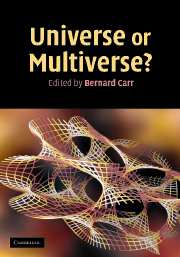Book contents
- Frontmatter
- Contents
- List of contributors
- Preface
- Acknowledgements
- Editorial note
- Part I Overviews
- Part II Cosmology and astrophysics
- Part III Particle physics and quantum theory
- Part IV More general philosophical issues
- 20 Scientific alternatives to the anthropic principle
- 21 Making predictions in a multiverse: conundrums, dangers, coincidences
- 22 Multiverses: description, uniqueness and testing
- 23 Predictions and tests of multiverse theories
- 24 Observation selection theory and cosmological fine-tuning
- 25 Are anthropic arguments, involving multiverses and beyond, legitimate?
- 26 The multiverse hypothesis: a theistic perspective
- 27 Living in a simulated universe
- 28 Universes galore: where will it all end?
- Index
- References
27 - Living in a simulated universe
Published online by Cambridge University Press: 05 July 2014
- Frontmatter
- Contents
- List of contributors
- Preface
- Acknowledgements
- Editorial note
- Part I Overviews
- Part II Cosmology and astrophysics
- Part III Particle physics and quantum theory
- Part IV More general philosophical issues
- 20 Scientific alternatives to the anthropic principle
- 21 Making predictions in a multiverse: conundrums, dangers, coincidences
- 22 Multiverses: description, uniqueness and testing
- 23 Predictions and tests of multiverse theories
- 24 Observation selection theory and cosmological fine-tuning
- 25 Are anthropic arguments, involving multiverses and beyond, legitimate?
- 26 The multiverse hypothesis: a theistic perspective
- 27 Living in a simulated universe
- 28 Universes galore: where will it all end?
- Index
- References
Summary
Introduction
A good point of philosophy is to start with something so simple as not to seem worth stating, and to end with something so paradoxical that no one will believe it.
Bertrand RussellOf late, there has been much interest in multiverses. What sorts could there be? And how might their existence help us to understand those life-supporting features of our own universe that would otherwise appear to be merely very fortuitous coincidences [1,2]? At root, these questions are not ultimately matters of opinion or idle speculation. The underlying Theory of Everything, if it exists, may require many properties of our universe to have been selected at random, by symmetry-breaking, from a large collection of possibilities, and the vacuum state may be far from unique.
The favoured inflationary cosmological model — that has been so impressively supported by observations of the COBE and WMAP satellites — contains many apparent ‘coincidences’ that allow our universe to support complexity and life. If we were to consider a ‘multiverse’ of all possible universes, then our observed universe appears special in many ways. Modern quantum physics even provides ways in which the possible universes that make up the multiverse of all possibilities can actually exist.
Once you take seriously that all possible universes can (or do) exist, then a slippery slope opens up before you. It has long been recognized that technical civilizations, only a little more advanced than ourselves, will have the capability to simulate universes in which self-conscious entities can emerge and communicate with one another [3]. They would have computer power that exceeded ours by a vast factor. Instead of merely simulating their weather or the formation of galaxies, like we do, they would be able to go further and watch the appearance of stars and planetary systems.
- Type
- Chapter
- Information
- Universe or Multiverse? , pp. 481 - 486Publisher: Cambridge University PressPrint publication year: 2007
References
- 10
- Cited by



